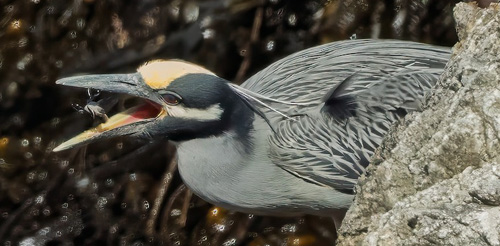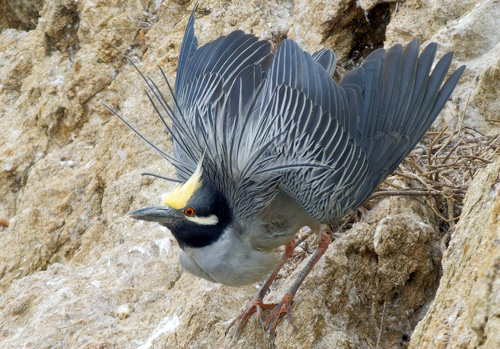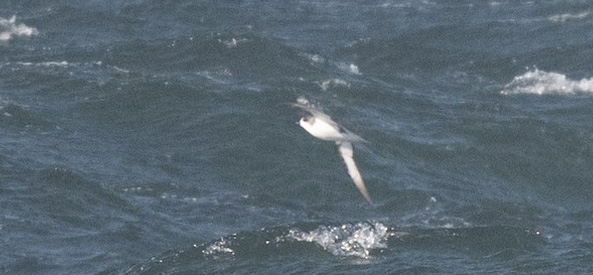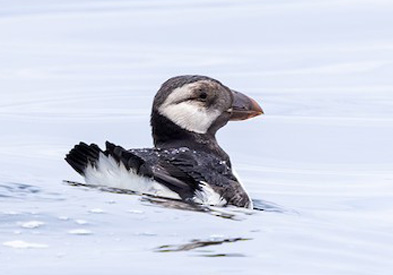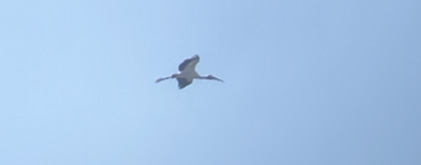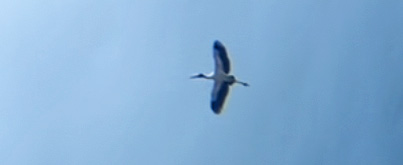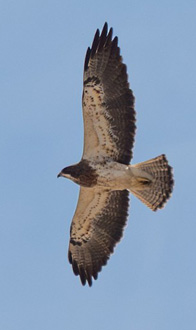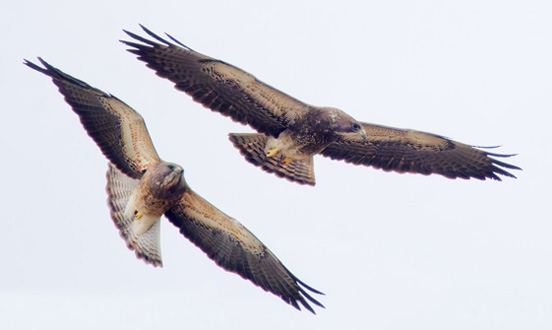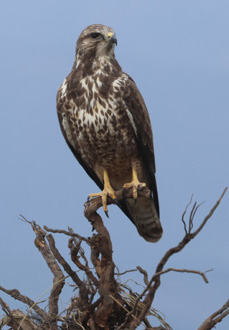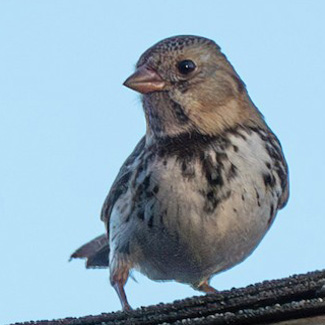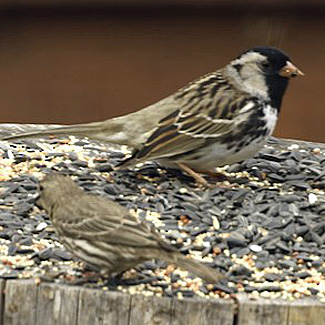These highlights chronicle the year 2025. The year runs generally
"backwards" on this page. In crediting records of vagrant or unusual birds, I always try to credit the finder(s) of the rarity. There will be times when complications arise with credit (e.g., one or more observers find a bird but others are the ones to actually identify it). There are times when a bird is properly identified only days later after photo review.
These summaries are not meant to be a "complete" record of birds of interest in MTY in any season — the reports forwarded to the Seasonal Editors of North American Birds magazine are intended to fill that niche — but, rather, these pages are of highlights of a portion of the year that were documented, in most cases, with photos.
The abbreviation "MTY" means "Monterey County"
in the text below. Text by Don Roberson. Photos on this page
are copyrighted by the photographers to whom they are
attributed, and may not be reproduced in any form (including
other web sites) without the express consent of the photographer. |
| |
The saga of MTY's only Yellow-crowned Night Heron continued. It had returned for a second winter to its roost at Stillwater Cove, Pebble Beach, on 23 Nov 2024 and remained through 24 Mar 2025. This wintering date span was similar to the date span during 2023-2024, in its first winter here.
It next appeared at the small Black-crowned Night Heron breeding colony at Bird Island, Point Lobos State Reserve, on 28 May 2025 (Sara Courtneidge). It successfully foraged on the rocks at low tide (photo upper right, catching small crab, 17 June © Sara Courtneidge).
Our Yellow-crowned also showed a bit of wanderlust, appearing at Carmel River State Beach, and roosting a bit upstream on the morning of 9 June (Mark Chappell, Carole & Larry Rose).
Then, as Black-crowned Night Herons were feeding fledglings, our Yellow-crowned took to standing next to or on an unoccupied nest and performed bowing behaviors suggesting courtship (photo below right, 24 June © Mark Chappell). By late June it attracted an adult Black-crowned, and on 30 June, copulation was documented. The Pt. Lobos bird proved to be a male.
In southern California, multiple Yellow-crowned Night Heron pairs have nested, primarily in San Diego County, but some hybrid pairs have been documented (fide Curtis Marantz). It will be interesting to see what happens with this breeding attempt — it is quite late in the breeding season here —and to follow up on any further nesting attempts in its future.
|
|
|
| |
 |
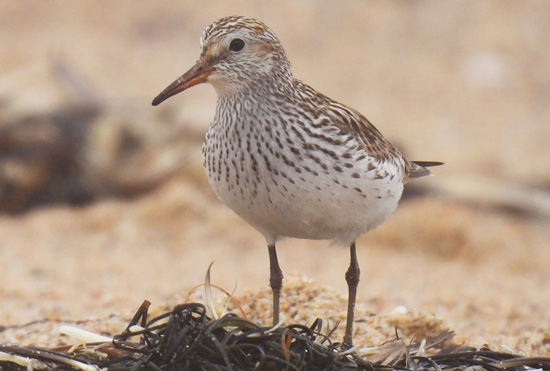 |
During June, sandpipers are very few along the sandy shoreline of the saline pond near the beach at Salinas River NWR. The few present were far away (access is restricted at this Snowy Plover breeding site) and views obscured by strong winds and blowing fog (above). Yet, on 27 & 28 June, Stephanie Coates and Brian Sullivan, independently, found and documented a breeding- plumaged White-rumped Sandpiper on that distant shore. Observers on 29 June were more fortunate to find it on ocean beach just to the west, and obtain closer photos (left, 29 June © Teale Fristo); by 30 June, it had moved back to the saline pond shore.
This was the 6th record for MTY, and comes on the heels of the county's 5th record during the first week of June. A discussion of prior records and timing are included just below, within the text of that prior occurrence, just a couple of weeks earlier. |
|
| |
On 21 June, Brian Sullivan discovered a Neotropic Cormorant with a half-dozen or so Double-crested Cormorant at a restricted access facility in the lower Salinas Valley (a very nice comparison photo, with Neotropic to the right, photo right, © B.L. Sullivan). This is the 6th MTY record. Brian has been the finder of 4 out of the 6 documented records for the county, going back to August 2017. Most occurrences (4 of the 6) were scattered from August into November, with the other two in May and June (this one).
These tropical cormorants have been rapidly spreading throughout southern California for the past decade, and it seems likely that more of them will come our way again. |
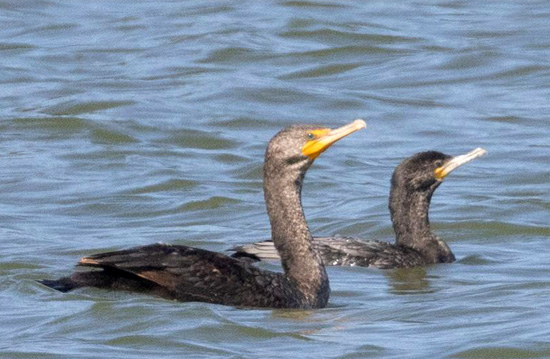 |
|
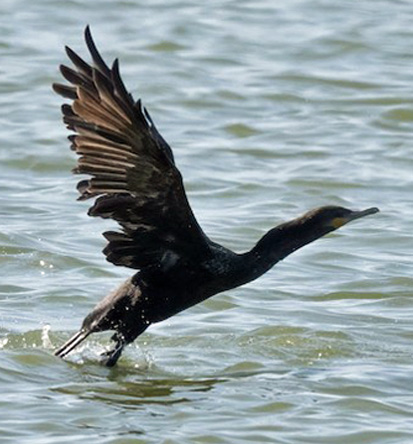 |
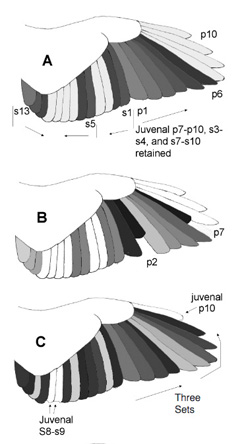 |
Karen Kreiger was with Brian on 21 June, and her photo of the Neotropic launching itself into flight (far left, 21 June © K. Kreiger) gives us a good view of its state of wing molt. Each wing looks very ragged, with worn & brown older feathers retained in patches among newer & black feathers growing in. According to Pyle (2006), a "common strategy for replacing remiges among large birds is 'Staffelmauser,' a German word meaning 'staggered molt' ... (that is) also known as 'stepwise' or 'serial' molt."
An illustration in Pyle's paper shows differing generations of flight feathers via shades of gray (photo near left). The Salinas cormorant appears have at least two sets of feather generations. Boobies, storks, condors, and some hawks are among the large birds that can be seen in a "Staffelmauser" molt. |
|
|
| |
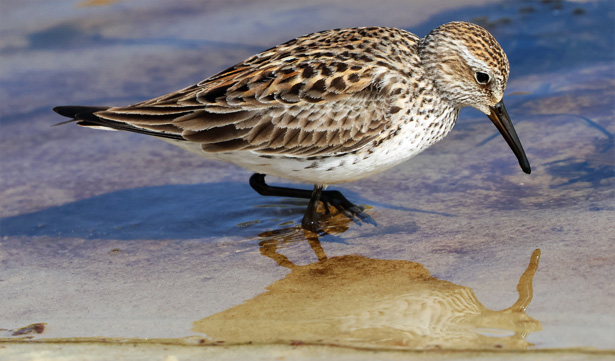 |
| On Friday, 6 June 2025, Rita Carratello and Don Roberson discovered a White-rumped Sandpiper at the tiny outlet puddle where Majella Creek drains through Asilomar State Beach (photos above & right, 6 June © D. Roberson). This long-distance migrant is a major rarity anywhere in California. There were 4 prior records for MTY — two in late May-early June, and two from early September — but the most recent one at a location open to the public was back in 1985. Thus, it was a State or even a Life bird for many local observers. Although the sandpiper was often harassed by a territorial Killdeer, and despite the heavy use of this sandy beach by tourists, dog-walkers, and surfers, it remained remarkably tame for the next two weekend days, and was seen and photographed by many birders from around California. |
|
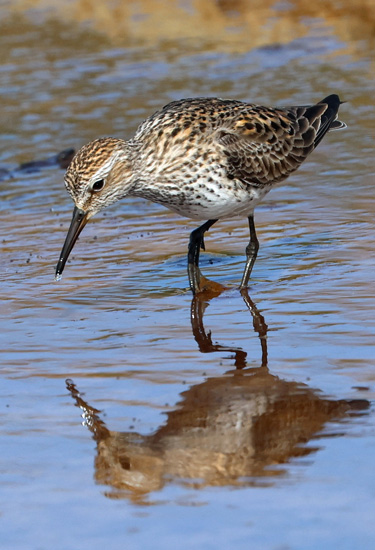 |
|
Additional interesting birds in June included an American Golden-Plover on Zmudowski SB on 3 June (Alex Krepelka) and single Least Terns at Salinas River mouth on 17 June (Rita Carratello) and 29 June (Mark Chappell). Small numbers of Black Skimmer have appeared in the Elkhorn Slough vicinity during this winter and in spring migration, but skimmers are much rarer on the Monterey Peninsula. So far this year we have had two such occurrences: 4 April at Stillwater Cove, Pebble Beach (Rita Carratello and her adult ed birding class) and 6-8 June at Carmel River lagoon (Lorna Claerbout, et al.).
The pair of Peregrine Falcon that first nested in the box atop the Embassy Suites Hotel in Seaside in 2020 (see that report) also used that nest box this spring, and hatched 3 young. The fledglings were exercising their wings by late May. New nesting locations for Cassin's Kingbird, surprisingly near the coast in northern MTY, were documented at Hudson Landing (Mark Kudrav) and Marina landfill (Paul Fenwick). At least 8 Indigo Buntings were reported in May-June, including a couple of potential pairs near the coast, and a male Rose-breasted Grosbeak was at Andrew Molera SP from 17 June onwards (Karen Kreiger et al.). |
| |
|
Strong winds at Pt. Pinos produced good seawatching in mid-May, and most impressive were numbers of Hawaiian Petrels seen from shore. It started on 18 May, when Karen Kreiger obtained this remarkable photo (above left) of an endangered pelagic species from Pt. Pinos (18 May © Karen Kreiger). Single Hawaiian Petrels were reported from 19 May, 22 May, 23 May, and 25 May, with a startling 3-5 spotted on 24 May.
Our understanding of the far offshore avifauna in Monterey County — 50-220 nautical miles offshore — has changed dramatically in the last 45 years. We learned in the late 1970s that long pelagic trips to the Davidson Seamount might find multiple Cook's Petrel in late fall. Research cruises in the early 1990s showed that many Cook's Petrel were present in April-May as well, as were good numbers of Murphy's Petrel. By the late 1990s, a few Hawaiian Petrel were recorded within 20 miles of shore in spring and fall. Today, re-positioning cruises in those offshore waters now regularly record these three Pterodroma petrels in Apr-May and again, sometimes, in Sep-Nov. Still, any Pterodroma petrel seen well enough to identify from shore remains a rare and special occurrence. The same seawatches this mid-May also produced a few Manx Shearwater, with occasional sightings into June (Kai Russell, et al.).
In early June, a whale-watching trip not far off Pt. Lobos found this Horned Puffin (above right, © Morgan Quimby), another significant rarity in MTY. Previously, between 3 April-14 May, whale-watching trips came upon a young Short-tailed Albatross on four occasions, presumably the same individual of this critically endangered species (Kavi Engel, Dana McDermott, et al.). |
| |
|
Three unexpected and amazing birds were found in Monterey County during April and May 2025:
- First, on 9 April 2025, Danae Mouton spotted and photographed a Wood Stork along the southern Big Sur coast, near Lucia (photos above, © Danae Mouton). We speculate that this quite rare bird anywhere in California must be the same individual that was present in Santa Cruz County 4-6 April, but moved substantial distances from near Año Nuevo SP to sites around the City of Santa Cruz during those 3 days. This is the third record of Wood Stork in MTY: two were seen (one adult collected) along the Salinas River on 29 June 1930 (McLean 1936), and an immature stork was on the old Post Ranch, on the Big Sur coast, between 10-31 July 1976. The latter was photographed by Ronald L. Branson on 18 July 1976; his photo appears in Roberson (2002). Wood Stork has declined precipitously at prior "usual" locations at the Salton Sea, and it was recently re-added to the California Bird Records Committee (CBRC) review list of major rarities. The odds of one appearing in MTY had seemed quite low.
- Second, on 16 May 2025, Mark Chappell was walking near his home in Pebble Beach when an adult Mississippi Kite circled over his head, landed briefly on a pine, and then flew off to the west. Mark's written description is in eBird. This fabulous rarity was anticipated as a rare migrant, particularly in spring. As of 2006, the CBRC book Rare Birds of California (Hamilton et al. 2007) listed the approval of 38 records — 14 in May — and has since dropped the species from its formal "review list." Still, this observation is the first record for Monterey County!
- Third, on 24 May, as Brian Sullivan was relaxing with a glass of wine on his backyard deck above Carmel Valley Village, he noticed a vulture drifting in from the north. He immediately recognized it was a Black Vulture. He dashed for the cameras, and obtained photos and video as it circled overhead and then headed east. This is the second record for MTY. The first was one mile north of Pacific Valley on the southern Big Sur coast on 14 May 2015, seen by Greg Smith, who had seen a long-running Black Vulture in adjacent San Luis Obispo County, including over his yard in that county (his details are in eBird). But the MTY Black Vulture story continues ....
|
|
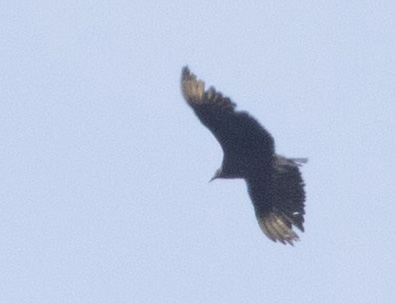 |
One of Brian Sullivan's photos of the Black Vulture over his yard is to the left (24 May © B.L. Sullivan).
At midday the following day (25 May), Alex Rinkert was at Hastings NHR in upper Carmel Valley, and saw the same Black Vulture circling overhead and then head south.
Then Carole & Larry Rose, who were out cruising Carmel Valley Road in hopes of spotting the rare vulture, learned of Rinkert's eBird report. They decided to drive farther east up Carmel Valley Road than intended, ending up at the "watershed summit" of that road, where the ridgeline separates the Carmel River watershed (to the west) from the Arroyo Seco watershed (to the east). |
They stopped and oh-my-gosh, there sat the Black Vulture on a telephone pole! It quickly took off to the south, and Carole got this flight shot (to the right, 25 May © Carole Rose).
The next day (26 May), Mark Chappell was "driving back from Fort Hunter Liggett when I saw the bird almost smack on the centerline of Carmel Valley Road, eating a road-killed California ground squirrel opposite the house at 45100 (Carmel Valley Road). I parked and took some photos" (below, 26 May © Mark Chappell). This spot is well down into the Arroyo Seco watershed, adjacent to Piney Creek.
At least 8 observers, including Mark, scattered among 6 vehicles, spotted the Black Vulture along a broad stretch of the southern end of Carmel Valley Road the afternoon of 26 May. All further efforts on successive days failed. |
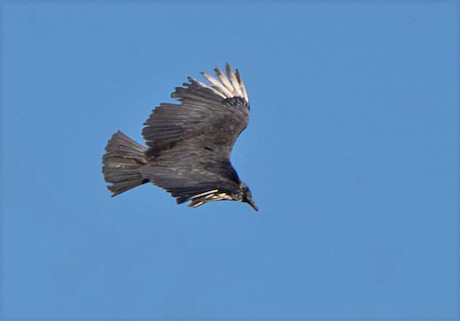 |
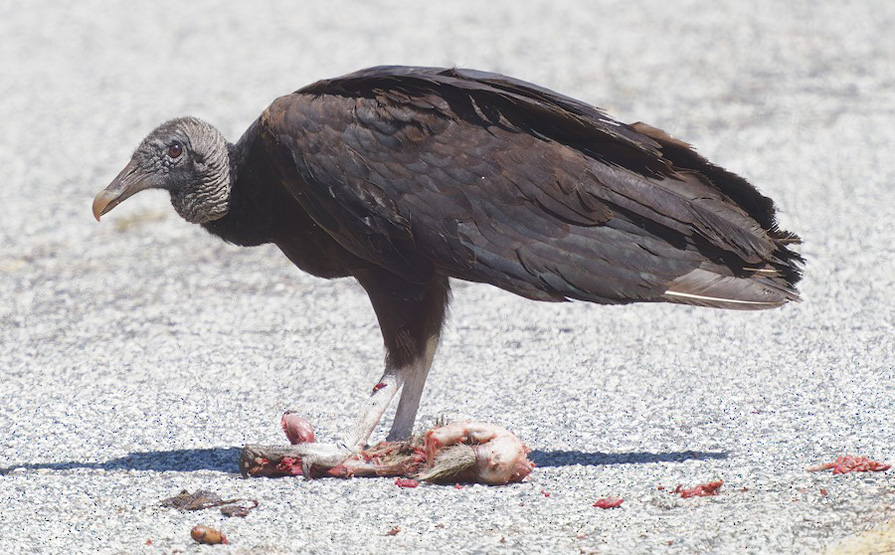 |
|
| |
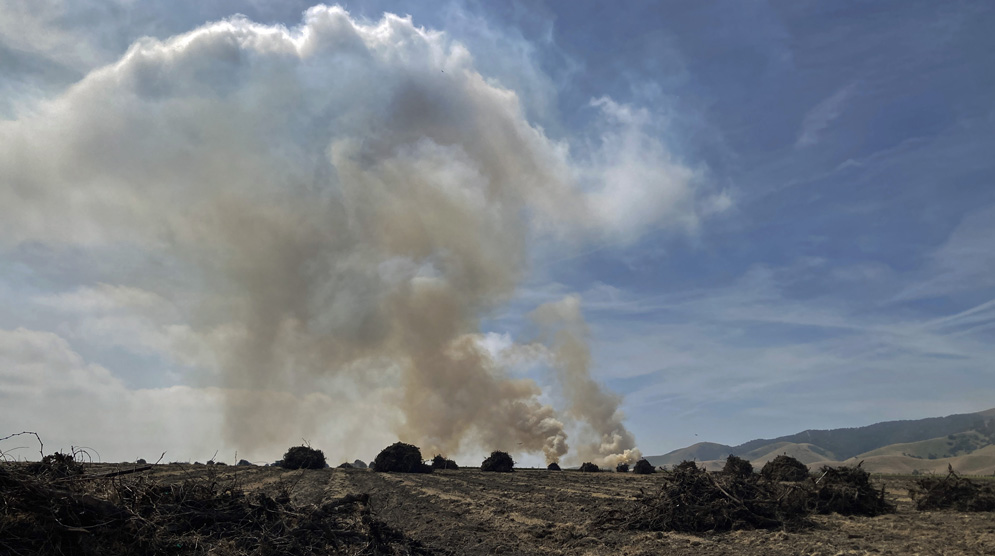 |
On 14 April, hawk expert Brian Sullivan located an unprecedented plethora of Swainson's Hawk for MTY. Private landowners south of Greenfield, centered along Central Avenue, were clearing out old vineyards, using tractors to push them into piles, and then burning the dry piles of vines. Brian conservatively estimated a dozen Swainson's that first day, but over the next two weeks, numbers increased as multiple observers took the drive south (Mark Chappell reported 37 present on 18 April). At least 17 were still present by 1 May, and at least one still present on 29 May, when the fires were fully burned out. Ravens were the commonest bird attracted to potential prey out-in-open during the fires, but some Red-tailed Hawks were also there daily; even a Golden Eagle checked it out. The amazing congregations of Swainson's Hawks included birds of all ages and multiple morphs, from light-morph adults (below left, 16 Apr © Carole Rose) to adults and sub-adults showing rufous morph characters (below middle, 18 Apr © Mark Chappell), but the most frequent were immatures of varying morphs (below right, 17 Apr © D. Roberson). Presumably these are all migrants. Our only recent nesting pair in Marina, in 2023 and 2024, were dark morphs. The habitat shot below has a Swainson's Hawk gliding in towards the burning piles (habitat shots above and below 30 Apr © D. Roberson).
Almost the entire population of Swainson's Hawk migrates annually from North America to Argentina, up to a distance of 10,000 km each way. To quote Cornell's Birds of the World on-line: "A highly gregarious species, the Swainson's Hawk forages and migrates in flocks sometimes numbering in the thousands. Its movement through Central America has been described as among “the most impressive avian gatherings in North America, since the demise of the Passenger Pigeon (Brown and Amadon 1968)." During migration and on the breeding grounds, "burning of fields concentrates foraging at edges of fields" (Bechard et al. 2020). Both Savanna Hawk Buteogallus meridionalis, in South America, and Grasshopper Buzzard Butastur rufipennis, in the African Sahel, are noted to forage in numbers over grass fires. |
|
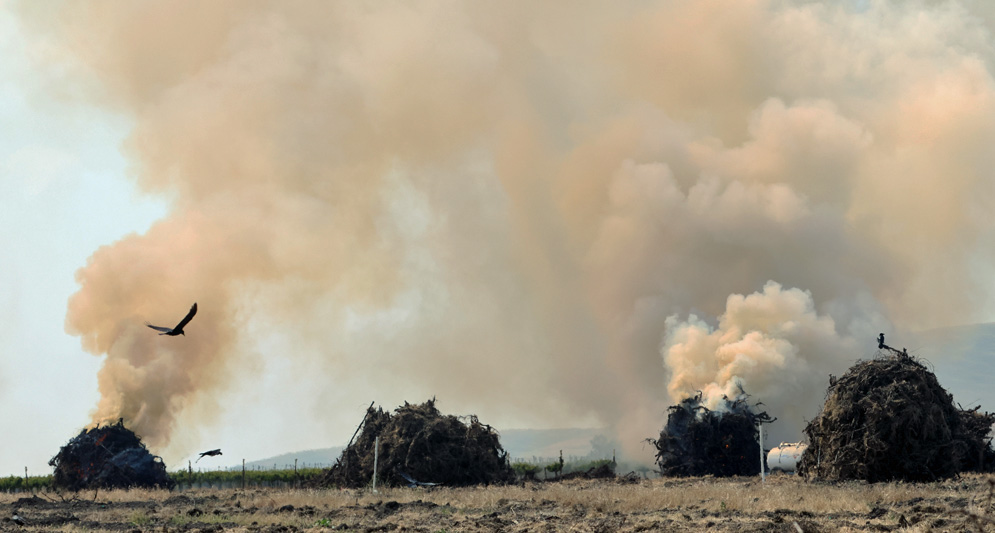 |
|
| |
| Most of the wintering rarities that lingered into 2025 had been found and documented in late 2024, as set out below. Another winter rarity, though, was discovered on New Years Day in Seaside: a Harris's Sparrow. It was first discovered in the backyard of Matt Tillett, who graciously arranged for access to his yard for local birders. It was a striking first-winter Harris's (photo below left, 2 Jan © Carole Rose). This backyard turned out to have all four species of Zonotrichia coming to the seed. Its routine, though, became irregular, and on 26 Jan, Todd Wills saw it in his backyard a block away — both yards being on or within a block of Shafer Street. For the next three weeks, it visited one or both yards with the regular group of Zonotrichia, until 15 Feb in the Tillett's yard and to 17 Feb at the Wills' yard. We were not sure where the sparrows went thereafter, until Bill Hubick and family purchased a home in the Shafer Street vicinity in mid-April. The first sparrow to come to seed in the Hubick's yard was, in fact, the Harris's Sparrow on 18 Apr and again 20 Apr, and finally on 2 May, when it was quite late in the season and in full breeding plumage (photo lower right, 2 May © Bill Hubick). What a way to start a "yard list!" |
| There are now 22 records of Harris's Sparrow in MTY, the vast majority appearing with other sparrows at backyard feeders in winter. |
| |
Early winter 2025 was rather dry and warm, and locals began the New Year by checking on the lingering rarities from 2024. These included:
- the Tropical Kingbird present for its 6th consecutive winter at Laguna Grande, present this winter from 28 Sep 2024-1 May 2025 (late date Rita Carratello)
- an Eastern Phoebe along the Carmel River mouth found 20 Oct 2024 stayed until 14 Feb 2025 (late date Carole & Larry Rose)
- "George," a hybrid or intergrade Western x Glaucous-winged Gull, present at Laguna Grande for its 13th consecutive winter, was there 11 Oct 2024-15 Feb 2025 (v.ob.)
- a Green-tailed Towhee at a neighborhood near Castroville, found 21 Nov 2024, lingered to 16 April 2025 (late date Rita Carratello)
- two wintering Magnolia Warblers — the 4th & 5th winter records for MTY — were present. A male at Carmel River mouth from 25 Dec 2024-22 Apr 2025 had molted into spring plumage and was singing on its last date (Michael Rieser). The other, at Del Monte Lake in the Naval Support Facility, Monterey, from 4 Jan-9 Feb 2025. This latter "Maggie" was discovered by Della Bossart just after the New Year, and she also recorded its last date.
Thereafter, heavy winter rains and storms in mid-January to February diminished birding opportunities. Winter conditions lingered into March and it became a very “late spring” for regular migrants, with most species arriving 2-4 weeks late. |
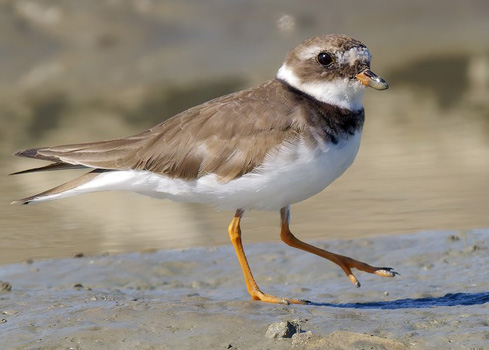
The most impressive winter rediscovery was that one of the Common Ringed Plover, documented last fall at a restricted access area near Salinas, actually wintered at that location. It was refound and documented on 23 March 2025 by Bill Hubick, Steve Tucker, Mark Chappell (photo left © Mark Chappell), and Kai Russell.
In his eBird report, Hubick wrote: "continuing adult that Mark Kudrav and I found on 10/10/2024. First over-wintering record in eBird for the West Coast. First March record for North America in eBird. Submitted to CBRC."
For more on the Common Ringed Plovers in MTY in fall 2024 and previously in fall 2023, see those reports. |
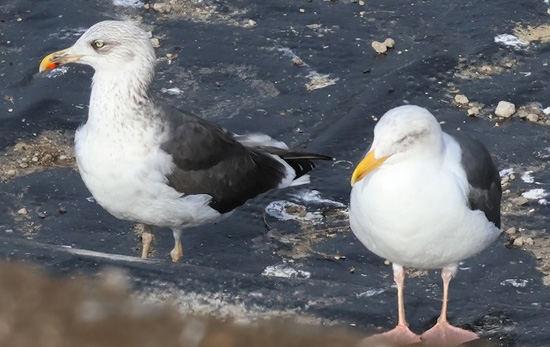
The wintering Common Ringed Plover was unexpected. More often in recent years has been an occasional Lesser Black-backed Gull with large gull flocks in winter. In 2025, Steve Tucker found two different Lesser Black-backs at the Marina landfill: a third-cycle gull on 4-6 January (photo right, Lesser Black-backed at left of the Western Gull, 4 Jan © Steve Tucker), and then a second-cycle individual on 22 March.
I think this brings the MTY total to 17 Lesser Black-backed Gulls, with six of them at the Marina Landfill. |
| |
Literature cited:
- Bechard, M. J., C. S. Houston, J. H. Sarasola, and A. S. England. 2020. Swainson's Hawk (Buteo swainsoni), version 1.0 in Birds of the World (A. F. Poole, ed.). Cornell Lab of Ornithology, Ithaca, NY, USA
- Brown, L. H., and D. Amadon. 1968. Eagles, Hawks, and Falcons of the World. McGraw-Hill, New York, NY, USA.
- California Bird Records Committee. 2007. Rare Birds of California (R.A. Hamilton, M.A. Patten, and R.A. Erickson, eds). Western Field Ornithologists, Camarillo, CA.
- Pyle, P. 2006. Staffelmauser and other adaptive strategies fir wing molt in larger birds. Western Birds 37:179–185.
- Roberson, D. 2002. Monterey Birds, 2d ed. Monterey Audubon Soc., Carmel, CA.
- Roberson, D., and C. Tenney, ed. 1993. Atlas of the Breeding Birds of Monterey County, California. Monterey Audubon Soc., Carmel, CA.
I thank Rita Carratello and Michael Rieser for editorial comments on an earlier draft of this page.
|
|
Page created 26 June-5 July 2025
TOP
GO TO
HOME PAGE
TO MONTEREY
COUNTY
PAGE
TO BIRD
FAMILIES
OF THE WORLD
|
